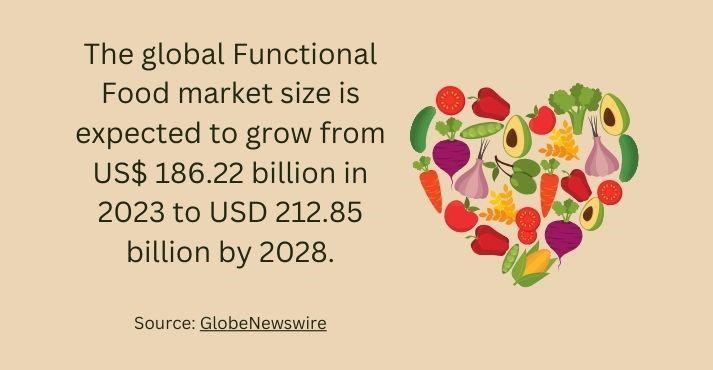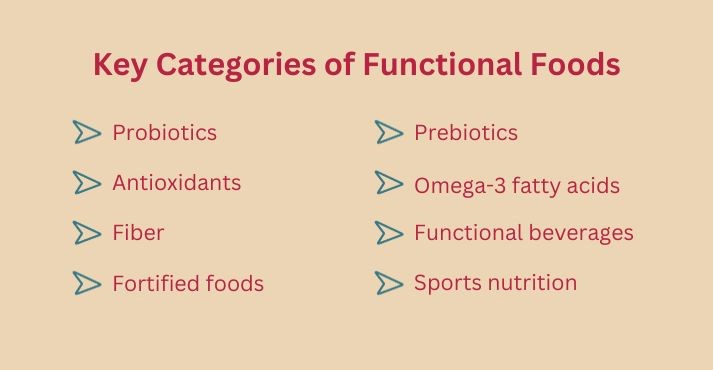The popularity of functional foods is increasing as consumers become more proactive, taking responsibility for their health and well-being.
New products have appeared in the market because of consumer interest in this category. Rapid advances in the scientific evidence support that functional nutrition and the progress in agricultural technology have all contributed to the accelerated recent attention to functional nutrition.
Understanding Functional Foods

So, before we begin with the Functional food market research, we must understand what it is. Functional foods are those intended to be consumed as part of the regular diet and contain biologically active components that offer the potential of enhanced health or reduced risk of disease.
For example, functional foods include calcium-rich foods, omega-3 fatty acids, fiber, and other vital nutrients that help maintain and reduce heart disease, cholesterol, and hypertension.
Consumers demand new functional food choices as vegan and organic food awareness increases. Functional foods are designed with specific health-promoting properties, making them popular among those looking to manage their well-being proactively.
The growing awareness of the link between diet and health, fueled by advancements in nutrition science and widespread information dissemination, further drives the demand for functional foods.
Global Functional Foods Market Overview

With the growing functional foods market, it is clear that consumers are demanding a radical transformation. As scientific and technological advances in health and nutrition, more focus has been directed towards the functional food market.
Some of the key statistics from functional foods market analysis are:
- The functional food market is expected to reach around US$ 268 billion by 2027.
- By 2028, the market will be worth over half a trillion U.S. dollars.
- The vitamin-based functional foods segment is growing at a CAGR of 7.1%.
- The Asia Pacific has a revenue share of over 9% in 2022.
- The Asia Pacific is expected to reach around 45 billion U.S. dollars by 2023.
Apart from these numbers, the global functional and natural health food market was valued at USD $23.5 billion and is expected to increase to USD $38.5 by 203. Mainly due to lifestyle changes and diet transformations, consumers are seeking value-added food products across the world.
Also, the health and wellness market is expected to reach US$ 7 trillion by 2025 as Consumers take a more aggressive and preventive approach to health.
The growth of these markets is directly linked to an increase in sales of functional foods, and the Global Functional Food market size is expected to grow from US $ 186.22 billion in 2023 to USD $212.85 billion by 2028.
Major Players in the Functional Food Market
The functional food market is a dynamic and rapidly growing industry with numerous major players vying for dominance.
The key players in the industry compete based on product innovation and development, branding, diversification, expansion, acquisitions, regulatory compliance, sustainability, distribution channels, and personalization.
The major players in the functional foods industry are:
- Cargill
- BASF
- General Mills Inc.
- Standard Functional Foods Group Inc.
In this competitive landscape, key players strive to maintain their positions and gain market share by staying ahead of trends, addressing regulatory challenges, and fulfilling the ever-growing demand for functional and healthier food choices.
Key Categories of Functional Foods

Functional foods can be divided into two categories depending on nutritional values, benefits, and whether the nutrients are naturally found.
- Probiotics in yogurt and fermented foods such as cultured milk support gut health and digestion.
- Prebiotics in foods like garlic and onions support the growth of beneficial gut bacteria.
- Antioxidants in fruits and vegetables, like berries and leafy greens, protect body cells from damage.
- Omega-3 fatty acids in fish and flaxseeds help reduce inflammation and support heart health.
- Fiber in whole grains, legumes, and fruits aids digestion, regulates blood sugar and lowers cholesterol levels.
- Functional beverages like green tea and fortified water provide specific health benefits.
- Fortified foods like milk or cereal have added vitamins, minerals, or other nutrients to enhance their nutritional value.
- Sports nutrition, like energy gels, protein powders, and electrolyte drinks, enhances athletic performance.
Functional Food Trends and Consumer Preferences
The trends in the functional food market are transforming as food purchasing habits and consumption patterns are changing worldwide.
The shifting preferences and lifestyles drive a growing interest in plant-based foods, a rapidly expanding sector to include plant-based alternatives and alternative proteins. Also, consumers are demanding specialty food to satisfy their taste preferences.
Let’s look into key market trends and consumer preferences.
1. Increasing Consumption of Nutrient-Enriched Food
Nutrient-enriched foods refer to protein, fiber, vitamins A, C, and E, calcium, magnesium, iron, and potassium that do not refer to non-health-promoting nutrients like saturated fat, sodium, and added sugar.
Nutrient-enriched foods offer a healthier, eco-friendly option for consumers seeking essential nutrients without animal-derived ingredients. Therefore, due to health benefits, plant-based dairy alternatives are becoming an increasing choice worldwide.
Moreover, menu labeling is becoming common among food manufacturers as consumers ask for nutritional labels and values in the food product.
2. Asia-Pacific Dominates the Market
The valuation of the Asia Pacific functional food market will reach USD $4.34 billion in 2023 and grow at a CAGR of 6.9%.
This region, which includes countries such as China, India, Japan, and South Korea, has experienced remarkable growth in the consumption and production of functional foods.
Factors like rising health awareness, an aging population, and increased disposable income have driven the demand for products that offer specific health benefits beyond essential nutrition.
Food manufacturers in the Asia Pacific market are developing innovative products to meet the growing consumer demand further and strengthen their market presence.
3. Increasing Technological Advancements in Production
According to a study published by NY Times, due to the development of automation, robotics, and advanced manufacturing, workers now are producing 47 percent more than 20 years ago.
Cutting-edge techniques and processes, such as nanotechnology, encapsulation, and precision fermentation, are changing how functional foods are formulated and manufactured.
These advancements enable the precise control of nutrient delivery, enhance bioavailability, and extend shelf life, all while preserving the sensory attributes of the products.
Furthermore, automation and data analytics streamline production processes, improve efficiency, and ensure consistent quality.
Regulatory Environment
The Regulatory landscape governing functional foods is characterized by a complex interplay of laws and guidelines to ensure these products’ safety and accurate labeling.
The FDA regulates functional foods in the United States, requiring manufacturers to provide scientific evidence of their health claims and adhere to labeling standards.
The European Food Safety Authority evaluates health claims in the European Union, while the Novel Foods Regulation gas overns new ingredients.
Regulatory authorities are ensuring that labeling requirements for food products are met, and they must provide clear information on ingredients, nutritional facts, allergens, and expiration dates.
Certifications, such as organic, non-GMO, or fair trade, demonstrate a product’s compliance with specific standards and can influence purchasing decisions.
Maintaining a clear and harmonized regulatory framework is essential for consumer protection and industry growth as the demand for functional foods grows.
Challenges and Opportunities
The functional food sector is a growing segment. There are many challenges as scientific and industrial advances drive the market.
Consumer skepticism
As consumers are becoming more health-conscious, skepticism is also growing. Consumers are scrutinizing product claims and eco-labels as they are concerned with the effectiveness and safety of functional foods.
Misleading or unsubstantiated claims can erode trust in the industry. To address this challenge, the sector must focus on transparency, providing clear, evidence-based information, and ensuring regulatory compliance.
Building trust is crucial for the long-term success of the functional food market. Educating consumers about the nutritional values of the product will help consumers gain confidence and increase the brand’s credibility.
Competition
As the market grows, more companies enter the arena, leading to a crowded marketplace. Key players are utilizing new production machinery, integrating quality control systems, and using AI to analyze the data to improve the functional product outcome further.
Therefore, to thrive in this environment, companies must invest in research and development to create innovative products that stand out. Collaborations with scientific experts and health professionals can add credibility to a brand.
Innovation
Innovations in the functional food industry in recent years mainly refer to new scientific and technical approaches in food processing and the introduction of novel flavors utilizing nutrient-rich foods.
New ingredients, processing techniques, and delivery methods are constantly emerging, and companies need to invest in research and development to incorporate these innovations into their products.
The future for the functional foods market looks stronger still. Despite many challenges, there are untapped opportunities that the functional food market can benefit from.
Here are some key opportunities to unlock:
- Personalization: Functional food consumers can benefit by tailoring nutrients according to their specific health needs and preferences. Companies that invest in personalization through DNA testing understand the unique needs of their customers and deliver food accordingly.
- Plant-based functional foods: Consumers are seeking healthier, eco-friendly alternatives, creating a demand for functional foods that are both nutritionally beneficial and environmentally responsible.
- Immune health and wellness: The functional food market can capitalize on this by developing immune-boosting products rich in vitamins, minerals, antioxidants, and probiotics.
- Convenience functional foods: There’s a growing need for easy-to-consume, on-the-go functional food options
Functional Foods Market (FAQs)
How much is the Asia Pacific functional food market share?
Asia Pacific’s functional food market is expected to reach around US$ 21.45 billion by the end of 2023. Mainly due to increasing consumer interest, a better understanding of immunity-enhancing properties, changing food habits, and demand for fortified foods.
Which segment currently has the highest market share?
The dairy category, which includes yogurt and fermented foods, holds the highest market share. The revenue from the dairy products and egg market amounts to USD $12,470 million in 2023 and is expected to grow annually by 6.94% (CAGR 2023-2028).
What is the leading market trend?
The growing demand for healthy and nutrient-rich diets is the leading market trend in the functional foods market.
Conclusion
As we explored the Asia Food and Beverage Statistics in the functional food market segment, it is evident that health-conscious trends will persist and evolve.
Despite critical challenges faced by the functional food industry, staying ahead in this dynamic landscape requires continuous research with sound science and adherence to regulatory standards.
On the positive side, growth opportunities are immense for food manufacturers to explore by introducing nutrition, plant-based and sustainable options, immune health products, and convenient on-the-go choices.
Companies can meet consumer needs and contribute to a healthier, more informed world by adapting to the changing landscape, embracing innovation, and prioritizing transparency.
As a future outlook, the well-being and the impact of their dietary choices will continue to drive consumer choices, and the demand for functional foods continues to surge.













